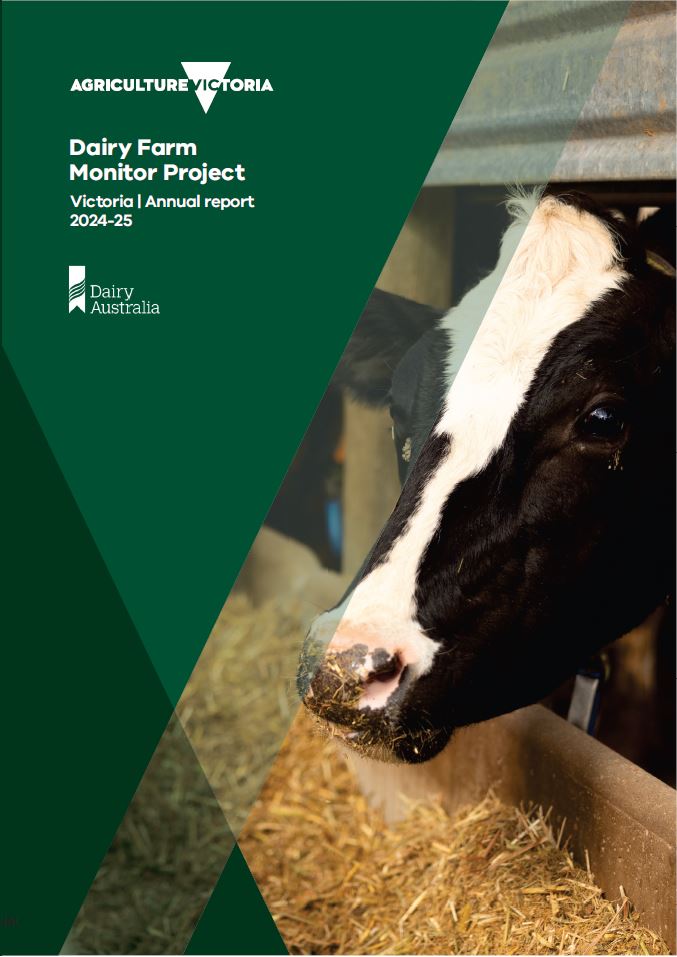Dairy Farm Monitor Project
The Dairy Farm Monitor Project is a comprehensive financial and production analysis of 80 Victorian dairy farm businesses in Northern Victoria, South West Victoria and Gippsland.
The project is a collaboration between Agriculture Victoria and Dairy Australia and has been completed for the 19th consecutive year.
Reports inform government and industry decision-makers on the farm-level factors that contribute to profit, and the information helps shape policy design, research themes and service delivery.
The results and trends reported need to be interpreted carefully, as participant farms should not be viewed as representative of the industry or region, and participant farms differ every year.
Industry reports
2024–25
Well-informed and timely decisions by Victorian Dairy Farm Monitor (DFM) participants helped manage the challenging dry conditions to record an average profit of $1.46 per kilogram of milk solids (kg MS) in 2024–25. Gross farm income was lower than the previous year, influenced by an 8% decrease in milk price (to $8.86/kg MS) and a decline in livestock trading profits.
The amount of directly grazed pasture was reduced in all regions, requiring greater amounts of feed to be purchased, increasing feed costs. Feed inventory declined in South West Victoria and Gippsland, as they used both current-year and stored feed. In contrast, average feed reserves increased in Northern Victoria, supported by reasonable access to irrigation water.
| Region | Overview report |
|---|---|
| Victoria | |
| Northern Victoria | |
| South west Victoria | |
| Gippsland | Gippsland overview [PDF File -1.2MB] |
2023–24
- Annual report 2023–24
 [PDF File - 7.9 MB]
[PDF File - 7.9 MB] - Annual report 2023–24 accessible
 [MS Word Document - 5.7 MB]
[MS Word Document - 5.7 MB]
Overall, average farm profit across the state decreased by 8% from the previous year to $2.64/kg MS. Variable seasonal conditions across the state influenced relative performance among the regions. Milk prices remained strong, with an average decrease of 1% to $9.64/kg MS compared to the previous year, while total costs remained stable compared to the previous year.
2022–23
In 2022–23, average profits across Victorian participants rose by 67% to $2.87/kg MS. Prices offered for milk supply increased on average by 33% and were the highest on record (accounting for inflation). Livestock trading profits reflected the type of livestock sold and the timing of sales as market prices declined sharply in the second half of the financial year.
Increased costs, most notably for purchased feed, were accompanied by general increases in costs across all categories. The widespread October flood event with subsequent storms in Northern Victoria put greater pressure on sourcing quality feeds at higher prices. South west Victoria and Gippsland managed wetter and drier (than typical) conditions for other portions of the year. Statewide, homegrown feed quality and quantity produced were reduced in 2022–23 compared to 2021–22.
| Region | Overview report |
|---|---|
| Victoria | |
| Northern Victoria | Northern Victoria overview Northern Victoria overview |
| South west Victoria | |
| Gippsland |
2021–22
The 2021–22 year was another positive one for the Victorian dairy industry. Average profit was the fourth highest in the 16 years of the project (accounting for inflation), reflecting the strong performance of DFM participants and was lower than the previous year’s high.
The strong performance in 2021–22 was influenced by a 9% increase in average milk price to $7.37/kg MS. However, the increased milk price coincided with higher input costs and supply constraints, including labour, feed and fertiliser, which impacted the overall 2021–22 farm business margins.
| Region | Overview report |
|---|---|
Victoria | |
Northern Victoria | |
South west Victoria | |
Gippsland |
2020–21
- Annual Report 2020–21
 [PDF File - 3.7 MB]
[PDF File - 3.7 MB] - Annual Report 2020–21 accessible
 [MS Word Document - 2.9 MB]
[MS Word Document - 2.9 MB]
In 2020–21, average farm earnings before interest and taxes (EBIT) rose to $1.86/kg MS. Livestock trading profit increased, fodder inventory increased, and costs decreased. Gippsland and the south west recorded close to the long-term average in 2020–21, with the north offering its best result in 15 years. A decline in milk price did not deter 75 of the 80 farms from recording a positive performance.
2019–20
A challenging first six months of 2019 to 2020 was followed by improved seasonal and business conditions in the second half of 2019–20 to lift performance across Victoria’s dairy regions compared to the previous year.
Dairy farmers were able to lower their costs and with a 17% improvement in milk price, EBIT increased to $1.68/kg MS.
| Region | Overview report |
|---|---|
Victoria | |
Northern Victoria | |
South west Victoria | |
Gippsland |
2018–19
It was a challenging year for the Victorian dairy industry in 2018–19 with mixed performance across the regions.
Profit was constrained by continued dry seasonal conditions and high input costs, particularly in irrigation water, grain and fodder. These costs were only partially offset by a 6% increase in milk price. On average, EBIT was $0.25/kg MS, a significant decline from the previous year.
| Region | Overview report |
|---|---|
Victoria | |
Northern Victoria | |
South west Victoria | |
Gippsland |
For earlier Dairy Farm Monitor Project annual reports please contact the team at fmp.victoria@agriculture.vic.gov.au or visit the Dairy Australia – Dairy Farm Monitor Project website.
